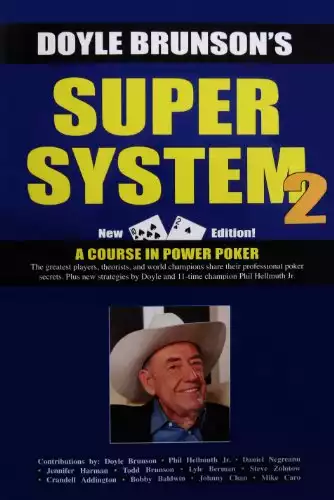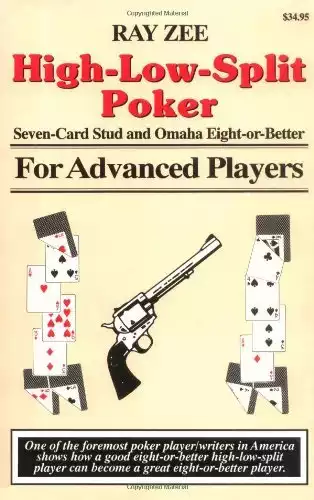Rules of the Game
Seven Card Stud High/Low Eight or Better (Stud8) is a split pot Seven Card Stud game where the best high hand splits with the best low. However, any low hand needs to at least be an eight low or better in order to qualify for half of the pot. This qualifier rule brings a lot more balance to the game in that high hands are now playable because they have the ability to win the entire pot and are no longer continuously free-rolled by lows virtually every hand.
The structure is the same as in Stud High where the low card brings in the action and future streets dictate that the high hand acts first. The one difference is that players no longer have the ability to make a big bet on 4th street when someone pairs their board.
Stud8 is a very important game to learn as it is often a part of virtually any mixed game. At one time it appeared that Super Stud8 was beginning to eclipse regular Stud8 in these games, however, “old school” Stud8 is once again regaining its foothold as the game of choice.
Starting Hand Standards
As is the case with all split pot games, starting hand selection is incredibly important. And in all Stud games, starting hands can’t be viewed in a vacuum as the value of a hand is highly dependent on the other cards on the board. Keep all of this in mind as you view the hierarchy of playable hands:
- Rolled Up Trips: Certainly trip aces is the hand you really want to see since you can beat any other trips, however, trip fives are not far behind. The reason is that trip fives helps block any straights that low draws are hoping to make and in addition it’s more often the case that you will get action from other hands such as a pair of kings.
- Three Suited Babies: The value of 5♣ 4♣ 3♣ and A♣ 2♣ 3♣ run very close because the former hand has the chance of making an opened straight draw while A23 is the best possible low and the ace also adds a lot of high value. Certainly you are ecstatic to see both hands and should put as much money into the pot on 3rd as you can. Even if you brick and other hands catch good your hand is good enough to see 5th
- Two Aces and a Low Card: This hand is very valuable as you almost always are starting out with the best high hand and also have the ability to make a low as well. Your chances of realizing your equity are thus very good.
- Three Low Cards to a Straight: These hands would include 234, 235, 345, 346, 456, and possibly higher depending what cards are out. For example against all high cards out 678 is much better than 234 because the nines and tens are not blanks. Obviously your hand holds a lot more value if you are two suited.
- Three Suited Lows: The value of these hands can differ drastically which makes it difficult to rank. For example (7♥ 5♥) 3♥ with no hearts out is a way stronger holding than (3♠ 7♠) 8♠ when you see spades out on board. Not only do you lack straight potential but it’s also a bad low draw with the eight out there for the world to see. This illustrates why you cannot value Stud8 hands in a vacuum, the value of your hand depends highly on the cards that you see.
- Ace and Two Low Cards: Once again there is a great discrepancy in the value of the hands within this group. (A♠ 5♥) 6♠ is definitely a better hand than (A♣ 8♥) 7♠. The first hand is almost always playable whereas the latter is not built to absorb much action. However, any of these hands play very well against a single opponent with a high card showing. When your ace is up you should always play aggressively in order to muddle your range.
- High Pairs: The higher pairs such as kings and queens are good starting hands although they do not play well against an ace. A good aggressive player will re-raise with any part of their playing range when they have an ace up therefore folding initially is not too tight especially where there are many low cards on board. However, if you are up against a player who will only re-raise with aces then you can play.
Preferably you want to play high pairs against lower high cards, a single low card, or at most two lows. Entering the pot when it’s likely you will be up against three or more lows card is a very dangerous proposition and you should probably fold.
Nines through jacks are not nearly as good as the highest pairs for a few reasons. The main reason is that when you are up against a low draw almost every single card in the deck will give them more equity. For example with a pair of nines every card except a nine will pair them, give them a low draw, or provide an over card to your pair. Then there is a greater possibility of being up against a higher pair in the hole. This is not to say you are never correct to play these pairs; it is just something to think about when the situation is close. For example, in a situation where two low cards show strength early you may choose to take your chances with kings but not jacks.
- Three Low Cards with Multiple Gaps: Hands of this type would include 236, 246, and 347. These hands are okay but even when you hit a great card at most you have a guts-shot or three outs to a pair of aces. They are playable in a lot of situations; however, always playing them would be a mistake.
- Flush Draws with Two Low Cards: If the cards you need are live these can be very good and deceptive hands. When the high card is in the hole, a card that looks like a brick may give you a flush draw accompanied with possible over card outs. With the high card up the possibility is there to back into a low hand that no one sees coming.
- Low Pairs with an Ace or Straight Flush Kicker: These hands are highly playable in shorthanded situations either as an ante steal or as an aggressive defense against a possible steal. They tend to not perform well in multi-way pots thus they should be folded in early position with a strong board or when it appears likely many players will contest the pot.
- Low Pairs with a High Card Kicker: Hands such as (44)K and (7Q)7 are best served for stealing antes or defending against steals. They hold value because with a king up you can get hands like jacks to fold on 3rd and in the case of (7Q)7 a queen on 4th or 5th looks like a brick but actually makes you two pair. However, keep in mind these hands are not good in multi-way pots or against a single player with an ace up.
- Three High Cards to a Straight Flush: While it’s a split pot game and in general in Stud8 you should hold the high pair that you represent this can be one of the exceptions. Even when you don’t hold three suits (Q♠ J♥) K♠ is definitely worth an ante steal with not many low cards behind you. There are plenty of improving cards for you on 4th street and you may even win the pot early when a junk low bricks out.
- Junk Low Hands: In other literature they are sometimes referred to as “Razz hands” but that may be insulting to some of the hands you would play in that game. These would include hands such as 267 and 852 that don’t have much of a chance to make a good low, a straight, or a flush. They can be used to steal antes, defend against a steal, or in a pot with all a lot of high cards but otherwise they should mostly be folded on 3rd
Further Learning
SuperSystem2 by Doyle Brunson, (Rating 8/10) – This particular chapter was written by Todd Brunson and is a very good introduction to the game of Stud8. It would receive a higher rating if it was longer and included more in depth examples but what is there is sound fundamental advice.
High Low Split Poker for Advanced Players by Ray Zee, (Rating 8/10) – Omaha Eight-or-Better is also included in the text and similar to SuperSytem2 it serves as very good introduction to the game. Similar to the previous review it would receive a higher rating if it explored more advanced topics and examples.


